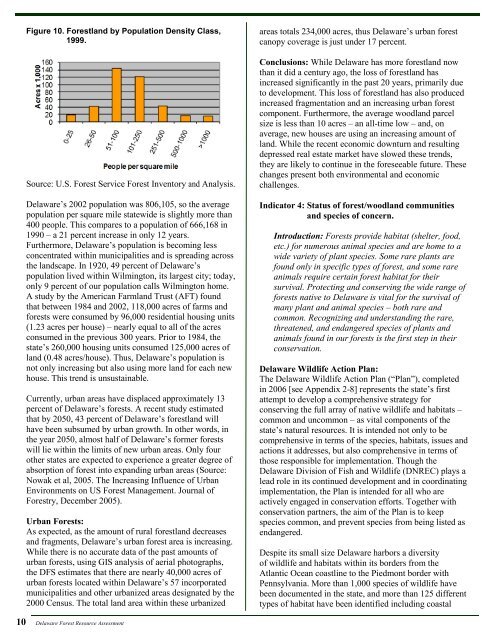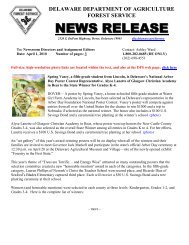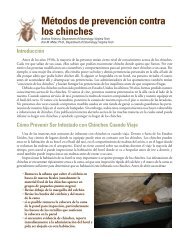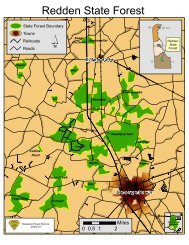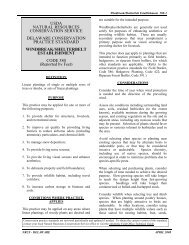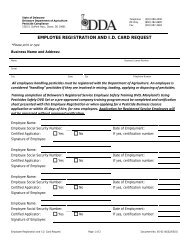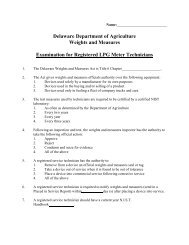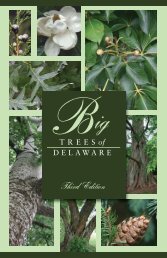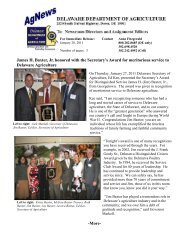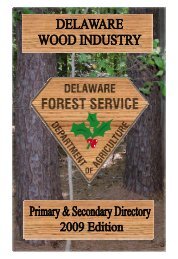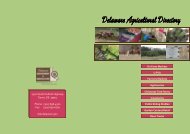DFS Resource Assessment - Delaware Department of Agriculture
DFS Resource Assessment - Delaware Department of Agriculture
DFS Resource Assessment - Delaware Department of Agriculture
You also want an ePaper? Increase the reach of your titles
YUMPU automatically turns print PDFs into web optimized ePapers that Google loves.
Figure 10. Forestland by Population Density Class,<br />
1999.<br />
Source: U.S. Forest Service Forest Inventory and Analysis.<br />
<strong>Delaware</strong>’s 2002 population was 806,105, so the average<br />
population per square mile statewide is slightly more than<br />
400 people. This compares to a population <strong>of</strong> 666,168 in<br />
1990 – a 21 percent increase in only 12 years.<br />
Furthermore, <strong>Delaware</strong>’s population is becoming less<br />
concentrated within municipalities and is spreading across<br />
the landscape. In 1920, 49 percent <strong>of</strong> <strong>Delaware</strong>’s<br />
population lived within Wilmington, its largest city; today,<br />
only 9 percent <strong>of</strong> our population calls Wilmington home.<br />
A study by the American Farmland Trust (AFT) found<br />
that between 1984 and 2002, 118,000 acres <strong>of</strong> farms and<br />
forests were consumed by 96,000 residential housing units<br />
(1.23 acres per house) – nearly equal to all <strong>of</strong> the acres<br />
consumed in the previous 300 years. Prior to 1984, the<br />
state’s 260,000 housing units consumed 125,000 acres <strong>of</strong><br />
land (0.48 acres/house). Thus, <strong>Delaware</strong>’s population is<br />
not only increasing but also using more land for each new<br />
house. This trend is unsustainable.<br />
Currently, urban areas have displaced approximately 13<br />
percent <strong>of</strong> <strong>Delaware</strong>’s forests. A recent study estimated<br />
that by 2050, 43 percent <strong>of</strong> <strong>Delaware</strong>’s forestland will<br />
have been subsumed by urban growth. In other words, in<br />
the year 2050, almost half <strong>of</strong> <strong>Delaware</strong>’s former forests<br />
will lie within the limits <strong>of</strong> new urban areas. Only four<br />
other states are expected to experience a greater degree <strong>of</strong><br />
absorption <strong>of</strong> forest into expanding urban areas (Source:<br />
Nowak et al, 2005. The Increasing Influence <strong>of</strong> Urban<br />
Environments on US Forest Management. Journal <strong>of</strong><br />
Forestry, December 2005).<br />
Urban Forests:<br />
As expected, as the amount <strong>of</strong> rural forestland decreases<br />
and fragments, <strong>Delaware</strong>’s urban forest area is increasing.<br />
While there is no accurate data <strong>of</strong> the past amounts <strong>of</strong><br />
urban forests, using GIS analysis <strong>of</strong> aerial photographs,<br />
the <strong>DFS</strong> estimates that there are nearly 40,000 acres <strong>of</strong><br />
urban forests located within <strong>Delaware</strong>’s 57 incorporated<br />
municipalities and other urbanized areas designated by the<br />
2000 Census. The total land area within these urbanized<br />
areas totals 234,000 acres, thus <strong>Delaware</strong>’s urban forest<br />
canopy coverage is just under 17 percent.<br />
Conclusions: While <strong>Delaware</strong> has more forestland now<br />
than it did a century ago, the loss <strong>of</strong> forestland has<br />
increased significantly in the past 20 years, primarily due<br />
to development. This loss <strong>of</strong> forestland has also produced<br />
increased fragmentation and an increasing urban forest<br />
component. Furthermore, the average woodland parcel<br />
size is less than 10 acres – an all-time low – and, on<br />
average, new houses are using an increasing amount <strong>of</strong><br />
land. While the recent economic downturn and resulting<br />
depressed real estate market have slowed these trends,<br />
they are likely to continue in the foreseeable future. These<br />
changes present both environmental and economic<br />
challenges.<br />
Indicator 4: Status <strong>of</strong> forest/woodland communities<br />
and species <strong>of</strong> concern.<br />
Introduction: Forests provide habitat (shelter, food,<br />
etc.) for numerous animal species and are home to a<br />
wide variety <strong>of</strong> plant species. Some rare plants are<br />
found only in specific types <strong>of</strong> forest, and some rare<br />
animals require certain forest habitat for their<br />
survival. Protecting and conserving the wide range <strong>of</strong><br />
forests native to <strong>Delaware</strong> is vital for the survival <strong>of</strong><br />
many plant and animal species – both rare and<br />
common. Recognizing and understanding the rare,<br />
threatened, and endangered species <strong>of</strong> plants and<br />
animals found in our forests is the first step in their<br />
conservation.<br />
<strong>Delaware</strong> Wildlife Action Plan:<br />
The <strong>Delaware</strong> Wildlife Action Plan (“Plan”), completed<br />
in 2006 [see Appendix 2-8] represents the state’s first<br />
attempt to develop a comprehensive strategy for<br />
conserving the full array <strong>of</strong> native wildlife and habitats –<br />
common and uncommon – as vital components <strong>of</strong> the<br />
state’s natural resources. It is intended not only to be<br />
comprehensive in terms <strong>of</strong> the species, habitats, issues and<br />
actions it addresses, but also comprehensive in terms <strong>of</strong><br />
those responsible for implementation. Though the<br />
<strong>Delaware</strong> Division <strong>of</strong> Fish and Wildlife (DNREC) plays a<br />
lead role in its continued development and in coordinating<br />
implementation, the Plan is intended for all who are<br />
actively engaged in conservation efforts. Together with<br />
conservation partners, the aim <strong>of</strong> the Plan is to keep<br />
species common, and prevent species from being listed as<br />
endangered.<br />
Despite its small size <strong>Delaware</strong> harbors a diversity<br />
<strong>of</strong> wildlife and habitats within its borders from the<br />
Atlantic Ocean coastline to the Piedmont border with<br />
Pennsylvania. More than 1,000 species <strong>of</strong> wildlife have<br />
been documented in the state, and more than 125 different<br />
types <strong>of</strong> habitat have been identified including coastal<br />
10 <strong>Delaware</strong> Forest <strong>Resource</strong> <strong>Assessment</strong>


